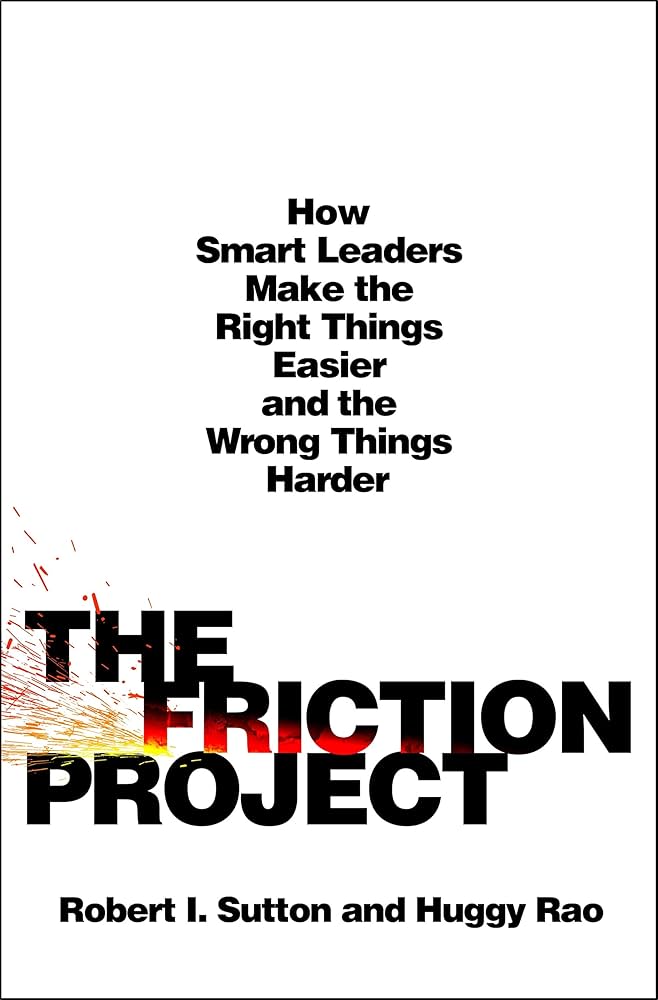The Friction Project 📚

The Friction project collects strategies for removing and adding friction so organisations function better.
Here are some choice cuts.
Why friction is good and bad
We soon learned that the goal of becoming a “frictionless organization” is misguided. Yes, the people who run most organizations create too much debilitating friction. But many also ignore the opposite side of the coin, making the wrong things too easy for employees and customers.
…
The harder we humans work at something, and the more we suffer, the more we come to value it (independent of its objective value) because of our need to justify all that work to ourselves and others.
A trustee of other’s time
In August 1940, as his country prepared for waves of attacks by German planes, Winston Churchill set out to address a different enemy. In his 234-word “Brevity” memo, 1 he implored his colleagues to “see to it that their Reports are shorter.” The British prime minister urged them to write “short, crisp paragraphs,” to move complex arguments or statistics to appendices, and to stop using “officialese jargon” and “woolly phrases.” A few months later, Churchill asked bureaucrats to hear his “cry of pain” and remember that “the number and length of messages sent by a diplomat are no measure of his efficiency.”
…
Rohm and Haas teaches its leaders that when they face a decision with broad and enduring consequences, taking speedy, narrow, and impulsive action is a recipe for disaster. Instead, Rohm and Haas preaches the Five Voices method. Before making a big decision, leaders slow down, do careful research, and talk to people until they understand five key stakeholders: the customer, the employee, the owner, the community, and the process.
…
“There comes a point where we need to stop just pulling people out of the river. We need to go upstream and find out why they’re falling in.”
Overcoming power poisoning
If you are more powerful than your colleagues or customers, you are at risk of being clueless about their friction troubles, and of how you add to their misery. Beware of such power poisoning.
…
“If you are the HIPPO, don’t be a hippo, be an elephant.”
i.e. have big ears rather than a big mouth.
…
The lesson, and perhaps the irony, of Tsedal and Sebastian’s study is that executives who deferred to subordinates moved up the pecking order faster than those who refused to bend to their underlings’ will and wisdom: Leaders were granted more power because they gave it away.
…
After Lindy’s team analyzed more than a hundred hours of observations and sixty interviews from ten start-ups, they found the best CEOs shifted between accentuating and flattening the hierarchy—and the worst ones treated the hierarchy as static.
When one CEO was asked if her team was flat or hierarchical, she explained, “You have to have both. If you don’t have that flat piece where you’re taking everyone’s input, you’re dropping expertise on the table, and if you don’t have a hierarchical piece, then you’re just heading in all different directions.” The best leaders “activated” their authority to squelch destructive conflict, when discussion and debate became repetitive, and time pressure necessitated immediate decisions. These flexible leaders “flattened” the hierarchy when creativity, problem-solving, and buy-in were top priorities.
Using subtraction to remove friction
People tend to add stuff to their work environments.
One of the more effective ways of removing destructive organisational friction is to instead subtract things.
Techniques for repairing coordination snafus
Onboard People to the Organization, Not Just the Job – Friction fixers who are intent on building a culture of coordination go beyond training newcomers to perform their narrow job responsibilities. They teach newbies how their work meshes with that of others, how the organization functions, and how to use the system to help them do their work. This saves a lot of trouble down the road.
…
Build Roles and Teams Dedicated to Integration – The idea here is to create specialists in your organization who are charged with integrating the once-disconnected roles, silos, and action. The Cancer Center created a centralized CarePoint program to reduce the cancer tax for patients and their families. CarePoint administrators use their knowledge and relationships to smooth patient journeys, and when problems arise, patients and families have a place to turn for help.
…
Fix Handoffs – Bungled information exchanges between people in different roles, silos, shifts, and time zones are among the most potent causes of coordination snafus.
Applying good friction
Anthropologists and sociologists document how, when something ends, people benefit from pausing to reflect on the past, what they’ve lost, what comes next, and what matters most and least to them—and to support one another. Be it the end of a meeting, a day, a game, a career, a life, a team, a project, or an organization.
…
Patty McCord, who was Netflix’s chief talent officer for the company’s first fourteen years, told us, “The most important role I played at Netflix was, at the end of every executive meeting, to say, ‘Have we made any decisions in the room today, and if we have, how are we going to communicate them?’”
Leading friction fixing
The third leadership principle is organizational design is the highest form of friction fixing. Most of the time, leaders don’t have the luxury of designing a workplace from scratch. So most must find ways to manage in existing and imperfect systems.